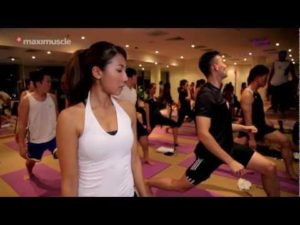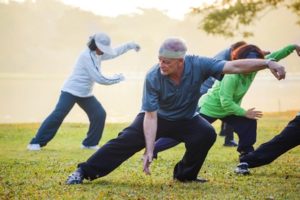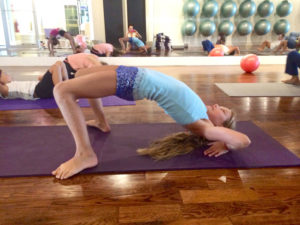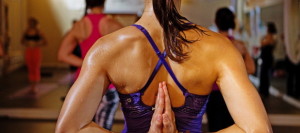Improve Functional Fitness with Yoga
By John M. de Castro, Ph.D.
“All forms of exercise are important for the body. The right amount of it keeps us in shape, improves longevity, and certainly keeps me sane if nobody else. Yoga is so much more than simple stretches, and it’s certainly not just for flexible people who can already wrap their legs around their heads. Yoga is about creating balance, strength, flexibility and relaxation in the body through a series of postures, movements and breathing patterns.” – Victoria Adams
We celebrate the increasing longevity of the population. But, aging is a mixed blessing. The aging process involves a systematic progressive decline of the body and the brain. Every system in the body deteriorates including motor function with a decline in strength, flexibility, and balance. It is inevitable. In addition, many elderly experience withdrawal and isolation from social interactions. There is some hope as there is evidence that these declines can be slowed. For example, a healthy diet and a regular program of exercise can slow the physical decline of the body with aging. Also, contemplative practices such as meditation, yoga, and tai chi or qigong have all been shown to be beneficial in slowing or delaying physical and mental decline.
Yoga practice has been shown to have a myriad of benefits for psychological and physical health. It is both an exercise and a mind-body practice that stresses both mental attention to present moment movements, breath control, and flexibility, range of motion, and balance. It has been shown to improve balance and flexibility in older individuals. It is safe and can be practiced by anyone from children to seniors. Recently, there have been a number of high profile athletes who have adopted a yoga practice to improve their athletic performance. But, the lack of exercise that is often associated with aging is a major problem. It is not known whether yoga practice is as good as traditional exercise programs in improving the overall functional fitness of sedentary older adults and slow the age related physical decline.
In today’s Research News article “Yoga Is as Good as Stretching–Strengthening Exercises in Improving Functional Fitness Outcomes: Results From a Randomized Controlled Trial.” (See summary below or view the full text of the study at: https://www.ncbi.nlm.nih.gov/pmc/articles/PMC5864160/ ), Gothe and McAuley recruited older sedentary adults over 55 years of age and randomly assigned them to engage in either 8 weeks, 3 times per week, Hatha yoga practice or stretching–strengthening exercises. The Senior Fitness test was administered before and after training. It measured strength, agility, balance, endurance, flexibility, and gait speed.
They found that both the yoga and stretching–strengthening exercise practices produced significant improvements in the older participants’ functional fitness for all measured parameters. So, yoga practice produced as good improvements in fitness as more traditional exercise. In, addition, yoga practice was found to produce significantly better leg balance than stretching–strengthening exercise. This is important as problems with balance contributes to falls in the elderly which is a major contributor to poor health and mortality.
These are important and interesting results that suggest that older individuals can choose between yoga and more traditional exercise to improve their fitness and slow their physical decline. In general, yoga practice has been found to be safe and effective and if practiced with groups it can also be more fun and tend to offset the social isolation experienced by the elderly. Hence, yoga practice may be an excellent choice to maintain fitness during aging.
So, improve functional fitness with yoga.
“Yoga promotes physical health in multiple different ways. Some of them derive from better stress management. Others come more directly from the physical movements and postures in yoga, which help promote flexibility and reduce joint pain.” – Harvard Health
CMCS – Center for Mindfulness and Contemplative Studies
This and other Contemplative Studies posts are also available on Google+ https://plus.google.com/106784388191201299496/posts and on Twitter @MindfulResearch
Study Summary
Gothe, N. P., & McAuley, E. (2016). Yoga Is as Good as Stretching–Strengthening Exercises in Improving Functional Fitness Outcomes: Results From a Randomized Controlled Trial. The Journals of Gerontology Series A: Biological Sciences and Medical Sciences, 71(3), 406–411. http://doi.org/10.1093/gerona/glv127
Abstract
Background.
Despite yoga’s popularity, few clinical trials have employed rigorous methodology to systematically explore its functional benefits compared with more established forms of exercise. The objective of this study was to compare the functional benefits of yoga with the conventional stretching–strengthening exercises recommended for adults.
Methods.
Sedentary healthy adults ( N = 118; Mage = 62.0) participated in an 8-week (three times a week for 1 hour) randomized controlled trial, which consisted of a Hatha yoga group ( n = 61) and a stretching–strengthening exercise group ( n = 57). Standardized functional fitness tests assessing balance, strength, flexibility, and mobility were administered at baseline and postintervention.
Results.
A repeated measures multivariate analysis of variance showed a significant time effect for measures of balance [ F (3,18) = 4.88, p < .01, partial η 2 = .45], strength [ F (2,19) = 15.37, p < .001, partial η 2 = .62], flexibility [ F (4,17) = 8.86, p < .001, partial η 2 = .68], and mobility [ F (2,19) = 8.54, p < .002, partial η 2= .47]. Both groups showed significant improvements on measures of balance (left–right leg and four square step); strength (chair stands and arm curls); flexibility (back scratch and sit-and-reach); and mobility (gait speed and 8-feet up and go), with partial η 2 ranging from .05 to .47.
Conclusions.
These data suggest that regular yoga practice is just as effective as stretching–strengthening exercises in improving functional fitness. To our knowledge, this is the first study to examine functional benefits of yoga in comparison with stretching–strengthening exercises in sedentary, healthy, community-dwelling older adults. These findings have clinical implications as yoga is a more amenable form of exercise than strengthening exercises as it requires minimal equipment and can be adapted for individuals with lower levels of functioning or disabilities.
https://www.ncbi.nlm.nih.gov/pmc/articles/PMC5864160/




